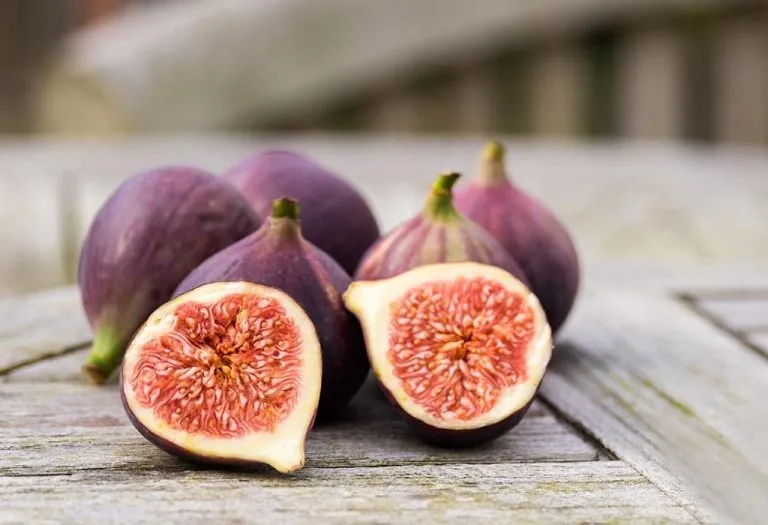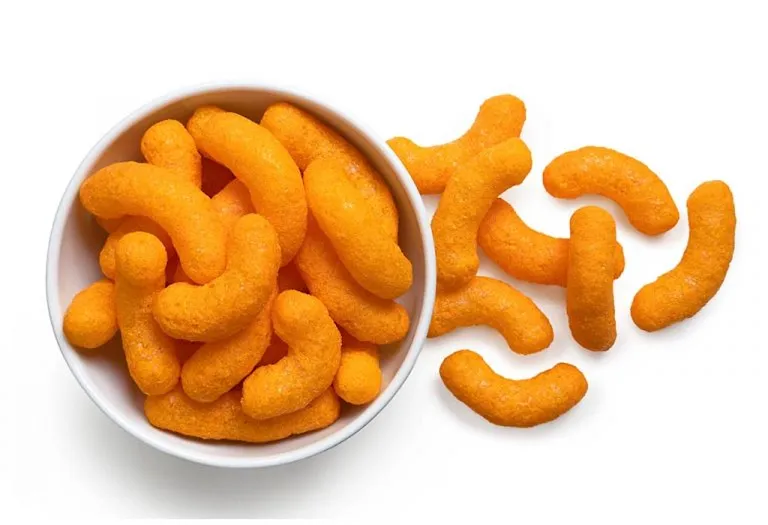Figs for Babies – Health Benefits and Quick Recipes

- Are Figs Safe for Babies?
- Nutritional Value of Figs
- Health Benefits of Figs for Infants
- When Can You Give Figs to Babies?
- How to Choose and Store Figs
- How to Prepare Figs for Babies
- Precautions to Take When Feeding Figs to Your Baby
- How to Prepare Figs for Baby-led Weaning
- Healthy Fig Recipes for Babies
- FAQs
Mothers often seek to experiment with different foods, trying to add variety to their baby’s diet. However, the biggest concern in their minds will always be whether a particular food is safe and beneficial for the baby. For example, figs for babies can be a great addition to their meals due to their nutritional value. Figs are one of the healthiest fruits, often consumed by adults who face digestive issues. Not only are they beneficial for adults, but figs are also one of the best natural supplements you can offer your baby. Rich in essential nutrients and minerals, they can help promote your child’s growth, improving digestion and supporting overall health. Including figs in your baby’s diet introduces a new flavor while providing valuable nutrients that contribute to their development.
Are Figs Safe for Babies?
Can babies eat figs? Yes, figs are safe for babies. They are a great nutrient and fibre source which can help your baby in growth and development. Figs are also an antimicrobial agent, which can help in the development of the immune system of the child. They are beneficial for the digestion system of the baby.
Nutritional Value of Figs
Here is the nutritional value of 100 gram of figs.
| Nutritional Component | Value per 100 g |
| Water | 79.1 g |
| Calories | 74 |
| Protein | 0.7 g |
| Total Lipid (fat) | 0.3 g |
| Carbohydrates | 19.2 g |
| Dietary fibre | 2.9 g |
| Vitamin C | 2 mg |
| Riboflavin | 0.1 mg |
| Vitamin B6 | 0.1 mg |
| Vitamin A | 4 ug |
| Thiamin | 0.1 mg |
| Niacin | 0.3 mg |
| Folate | 6 ug |
| Vitamin E | 0.1 mg |
| Vitamin K | 4.7 ug |
| Calcium | 35 mg |
| Iron | 0.4 mg |
| Magnesium | 17 mg |
| Phosphorous | 14 mg |
| Potassium | 232 mg |
| Sodium | 1 mg |
| Zinc | 0.2 mg |
Source: https://nutritiondata.self.com/facts/fruits-and-fruit-juices/1884/2
Health Benefits of Figs for Infants
There are many health benefits of figs for infants, and some of these anjeer benefits for babies are:
1. Digestion
Even among adults, figs have been known to alleviate gastric problems naturally. The digestive system of infants are only developing, and are weak when they are young – figs can be a great supplement and can also help them absorb the nutrients better.
2. Laxative
Ripe figs have large amounts of dietary fibre, which can help when it comes to constipation problems. Figs have been known as a natural laxative since they are high in fibre (1).
3. Essential Vitamins and Minerals
As evident above in the table, figs have a lot of nutrients and minerals which can help your child grow and develop well. Minerals like copper, iron, magnesium, potassium and calcium are extremely important for infants since their body is rapidly developing – and figs can provide them in adequate quantities (2).
4. Antimicrobial Properties
Figs are antimicrobial agents, which mean that they strengthen the immune system of the child as it is weak at young ages.
5. Liver
Infants are susceptible to a lot of infections and conditions like hepatitis and jaundice. Figs can provide adequate protection in this case – even doctors prescribe dried fig recipes for babies at times.
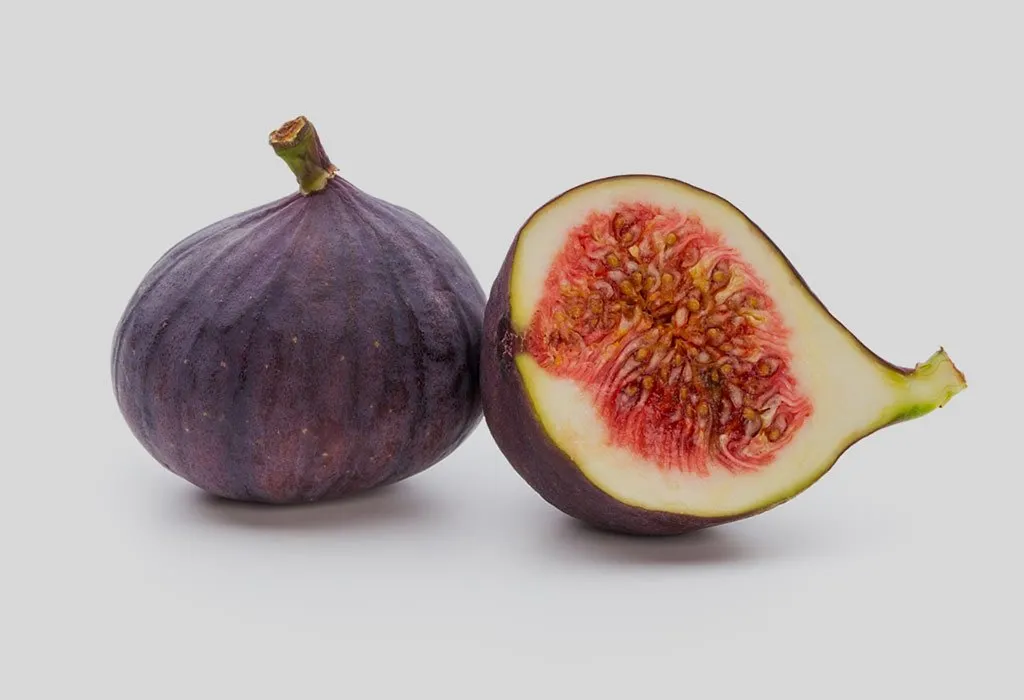
When Can You Give Figs to Babies?
Anjeer for babies can be introduced as early as six months, according to reports. However, you should ensure that the baby is comfortable with other foods before giving it.
How to Choose and Store Figs
When choosing fresh figs, check for any blemishes or marks that may be visible on the outside. With dry figs, always go for reputable brands with strong packaging. Figs can last around five days outside, and up to a week in the refrigerator when they are fresh. Store them in a dry place, or refrigerate them.
How to Prepare Figs for Babies
Depending on the age of the child and whether he is used to solid foods, you have a variety of recipes to choose from. Else, it would be better to give it in the liquid form, as fig syrup for babies.
Precautions to Take When Feeding Figs to Your Baby
When introducing figs to your baby’s diet, it’s important to take certain precautions to ensure they are safe and beneficial. Here are some key considerations to keep in mind before offering figs to your little one.
- Start with small amounts to see how your baby reacts, especially if it’s their first time trying figs.
- Make sure the figs are ripe, as unripe ones can be hard to digest and may cause stomach discomfort.
- Peel the skin, as it can be tough and difficult for babies to chew, which may pose a choking hazard.
- Avoid dried figs initially, as fresh figs are softer and easier to digest than the chewy texture of dried figs.
- Monitor for any signs of allergies, such as rashes or swelling, even though fig allergies are rare.
- Introduce figs after your baby reaches six months, once they’ve started on solids and are ready for new foods.
- Refrain from offering figs if your baby has diarrhea, as figs can have a natural laxative effect.
- Mash or puree the figs to ensure they are easy to swallow and digest for your baby, reducing the risk of choking.
- Offer figs in moderation, as they are high in fiber, and too much may lead to an upset stomach or gas.
How to Prepare Figs for Baby-led Weaning
Figs can be a great addition to your baby’s diet during baby-led weaning, as they are packed with essential nutrients. However, it’s important to prepare them appropriately according to your baby’s age to ensure they are safe and easy to eat. Here’s how you can prepare figs for different stages of your baby’s development:
For 6 to 9 Months
- Peel the fig and mash it well to prevent any choking hazards.
- You can mix mashed figs with other soft foods like yogurt or porridge for easier consumption.
- Serve in small, manageable amounts to help your baby get used to the taste and texture.
For 9 to 12 Months
- Offer small, bite-sized pieces of soft, peeled figs for your baby to self-feed.
- You can also mash the fig slightly and spread it on toast or mix with oatmeal.
- Monitor your baby closely as they practice handling small pieces.
For 12 Months and Up
- At this stage, you can offer larger slices of peeled figs for your baby to hold and bite into.
- Incorporate figs into salads or other dishes your toddler enjoys to introduce new flavors.
- Ensure the fig is soft and ripe to avoid any difficulty in chewing.
For 24 Months and Up
- You can now offer both fresh and dried figs, ensuring they are cut into small, bite-sized pieces.
- Try adding chopped figs to baked goods like muffins or pancakes for a nutrient boost.
- Encourage your toddler to try figs as part of a balanced snack, paired with other healthy foods.
Healthy Fig Recipes for Babies
You can use these recipes when you want to incorporate figs into your baby’s diet.
1. Fresh Fig Mash for Babies
This method is great if the baby has not grown used to chewing and solid food just yet.
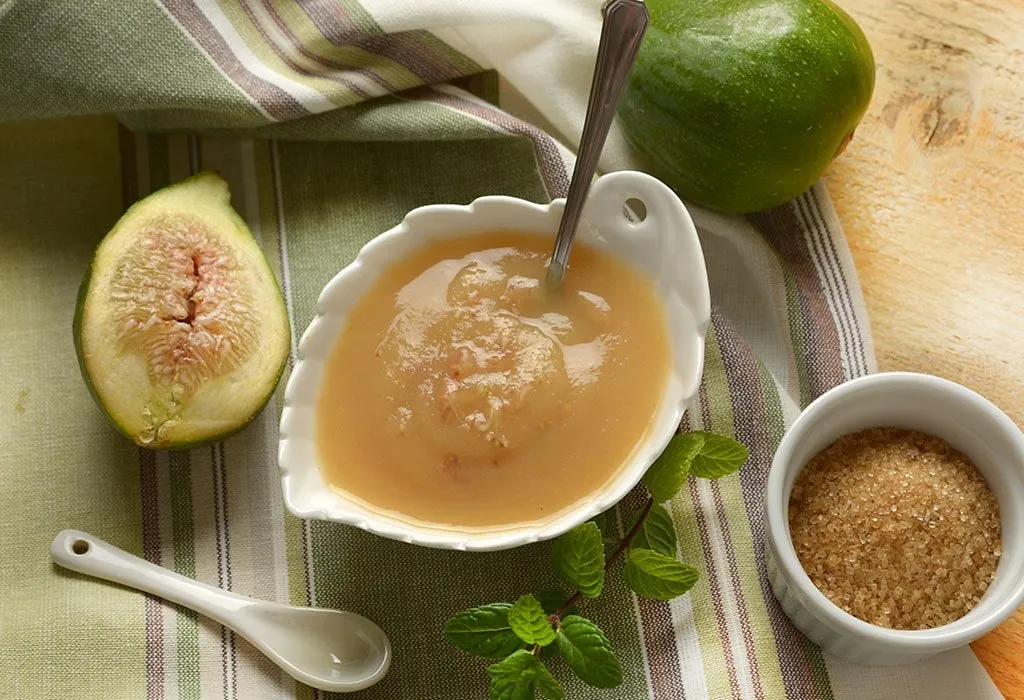
Ingredients
- Two fresh figs
Method
- This is fairly easy to make. First, chop the figs into small pieces.
- Then, just mix them or mash them up well to make a pulp or mash.
- You can also add this to porridge, to make it easier to eat for your child.
2. Baked Figs
If the baby has a taste for solid food and can chew well enough, this recipe is suitable. It is also easy to make.
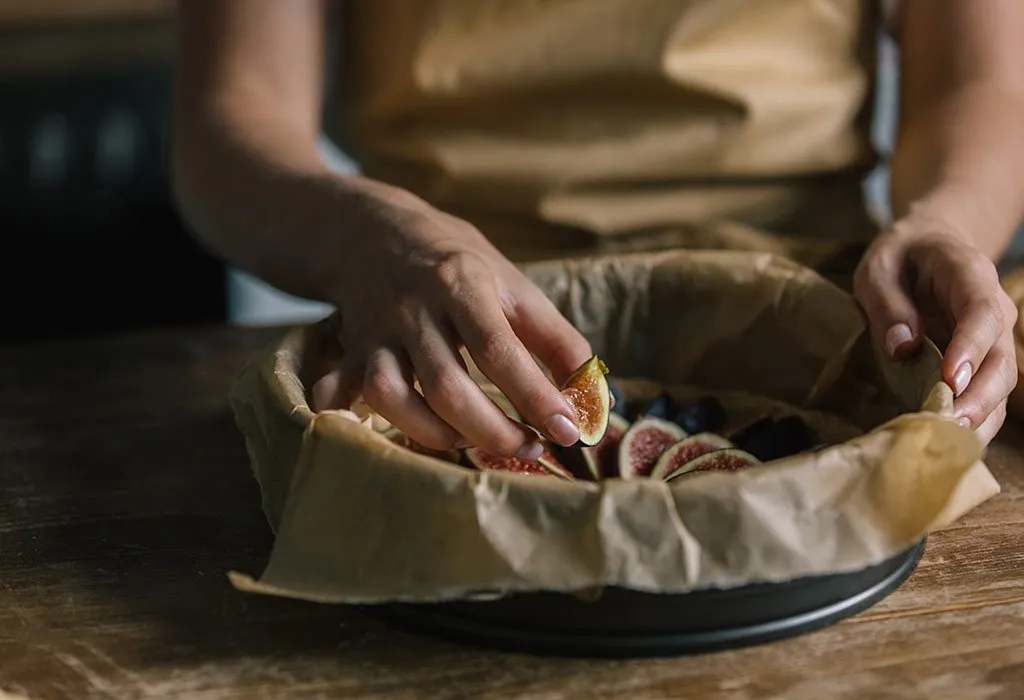
Ingredients
- 3 figs
- Olive oil
Method
- Preheat the oven, and place the figs inside with a coating of olive oil.
- Then, let them bake until the skin of the figs become puckered and soft.
- Mash the figs, and feed them to your child.
3. Fig Milkshake
This is easy to make, and your child will be asking for more!
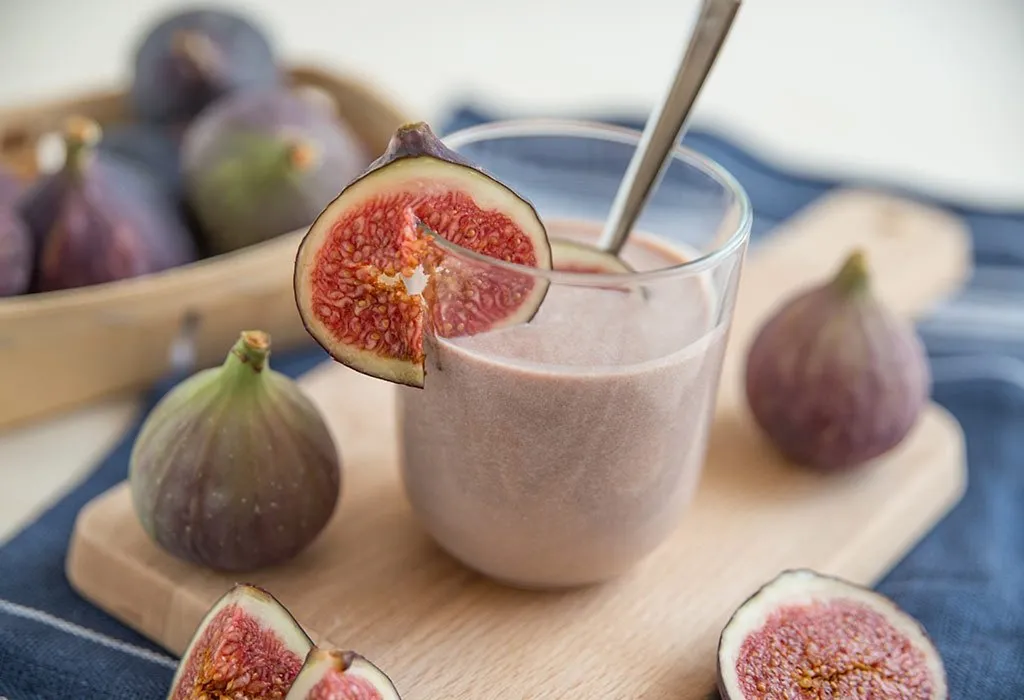
Ingredients
- Fresh figs
- Honey (not suitable for babies younger than one year of age)
- Milk
Method
- First, wash and chop the figs into small pieces.
- Then, simply blend all the mixtures and serve it cold.
4. Figs Soaked in Water
This is a traditional constipation recipe in Indian households.

Ingredients
- Figs
- Water
Method
- If the figs are fresh, just soak them in water overnight, and strain the liquid to give to the child.
- Else, boil the dry figs in water until the water becomes brownish, and feed to the child.
5. Dried Fig Puree
This is a great dried fig recipes for babies. This is also a suitable fig puree for babies who have not switched over to solid food yet.

Ingredients
- Figs
- Milk if necessary
Method
- First, soak the figs in warm water – 2 or 3 of them.
- Then, blend this water with the figs into a smooth puree, and you can even add breast milk or formula to smoothen the puree out.
6. Fig and Banana Porridge
This is a hearty and healthy breakfast option for babies starting solids.
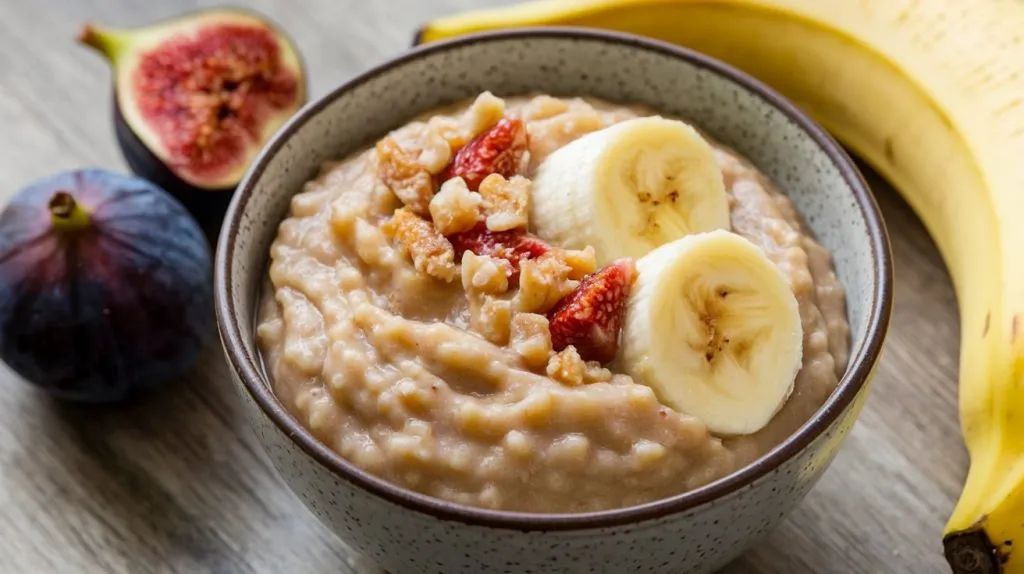
Ingredients
- 1 fresh fig
- 1 small banana
- Oats
Method
- Cook the oats as per package instructions.
- Mash the fig and banana together, and mix them into the cooked oats.
- Serve warm for a nutrient-rich meal.
FAQs
1. How many figs can I give to my baby daily?
It’s best to offer figs in moderation due to their high fiber content, which can lead to an upset stomach or gas if consumed in large quantities. One fig per day is usually sufficient for babies, but always monitor how your baby reacts.
2. Can figs interfere with my baby’s medication?
Figs contain natural compounds that can affect blood sugar levels and may interact with certain medications. If your baby is on any medication, consult your healthcare provider before introducing figs into their diet to ensure safety.
3. How can I tell if figs are ripe and safe for my baby?
Ripe figs should be soft to the touch and slightly wrinkled. They should have a sweet aroma and yield slightly when pressed. Avoid figs that are overly hard or have dark spots, as these may not be suitable for your baby.
Figs are a great source of nutrition for children and can help in the development of the digestive and immune systems in the child. However, make sure that the recipe you choose is suitable for your child to avoid fits and hisses!
References/Resources:
1. Oh. H, Lee. H, Seo. M, Kang. Y; Effects of Ficus carica paste on constipation induced by a high-protein feed and movement restriction in beagles (Laboratory Animal Research); ResearchGate; https://www.researchgate.net/publication/221736088_Effects_of_Ficus_carica_paste_on_constipation_induced_by_a_high-protein_feed_and_movement_restriction_in_beagles; December 2011
2. Calcium Content of Foods; UCSF Health; https://www.ucsfhealth.org/education/calcium-content-of-foods
3. Choking Hazards; CDC Nutrition; https://www.cdc.gov/nutrition/infantandtoddlernutrition/foods-and-drinks/choking-hazards.html
4. Vinson. J; The functional food properties of figs (Cereal Foods World); ResearchGate; https://www.researchgate.net/publication/279625587_The_functional_food_properties_of_figs
5. Figs, raw; Food Data Central; U.S. Department of Agriculture; https://fdc.nal.usda.gov/fdc-app.html#/food-details/173021/nutrients
6. Cruz. N, Bahna. S, Knight. A; Fig Allergy: Not Just Oral Allergy Syndrome (OAS); The Journal of Allergy and Clinical Immunology; https://www.jacionline.org/article/S0091-6749(06)02853-3/fulltext; January 2007
7. Mawa. S, Husaon. K, Jantan. I; Ficus carica L. (Moraceae): Phytochemistry, Traditional Uses and Biological Activities (Evidence-Based Complementary and Alternative Medicine); National Library of Medicine; https://www.ncbi.nlm.nih.gov/pmc/articles/PMC3789402/; September 2013
Also Read:
Pear for Baby
Oranges for Babies
Banana for Babies
Introducing Avocado to Babies
Was This Article Helpful?
Parenting is a huge responsibility, for you as a caregiver, but also for us as a parenting content platform. We understand that and take our responsibility of creating credible content seriously. FirstCry Parenting articles are written and published only after extensive research using factually sound references to deliver quality content that is accurate, validated by experts, and completely reliable. To understand how we go about creating content that is credible, read our editorial policy here.







